Text
Here’s a quick overview of how to play Treasure by Torchlight!
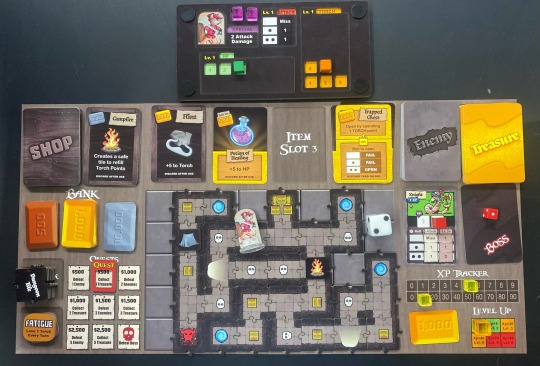
The basic premise of this game is to enter into randomly generated dungeons, fight monsters to earn XP, level up your character, collect loot and treasure, and ultimately defeat the final boss.
To start with you have 3 characters you can pick from! Each character has a special ability that you can save up and spend during a dungeon run.
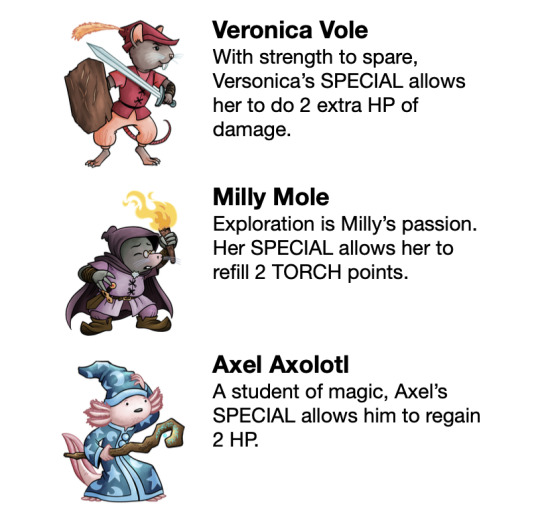
To move in a dungeon, you must spend torch points. If you are at the edge of a tile, you can place down a new tile and you will immediately move to that tile and engage with it.

If you back track over already placed tiles you cannot engage with them, but you will still spend torch points to move.

T-Tiles are special because they give you a choice. When you place a T-Tile you move to it and then select two additional tiles and place them on either side. You must then move to and engage with ONLY ONE of these options. Once you move you cannot go back and engage with placed tiles, so choose wisely!
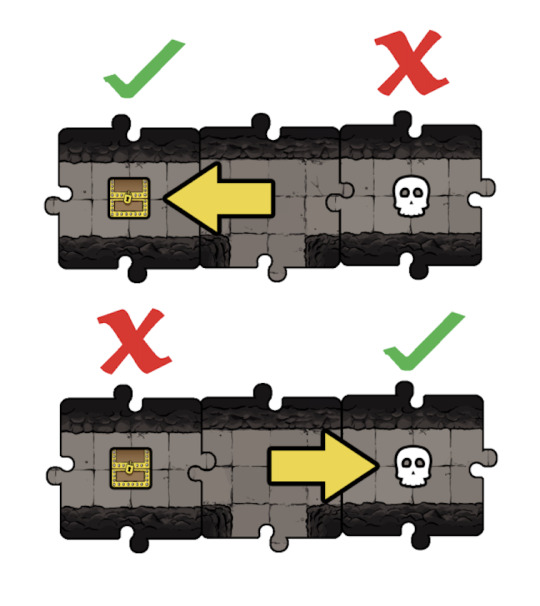
If you encounter an enemy you must immediately fight them. Rolling the dice determines the attack damage of both you and the enemy. Enemies can become stronger as you level up your character.

Enemies also have special points on them. You can spend an enemy card to refill your special attack points. But since you cannot level up until you exit a dungeon, spending an enemy card to refill a special point means you will not earn XP on that enemy. So choose wisely!
Defeating an enemy earns you XP which can be used to level up your character in the XP Tracker. The tracker is an abacus with the top numbers beings ones and the bottom numbers being tens.

Once you reach a certain amount of XP, you level up and swap out the modular level pieces on your character tracker. In this way you will begin to have more movement, attack, and health as you level up.


If you successfully exit a dungeon without dying, you can then spend your enemy cards to raise your XP and level up your character, go to the shop to buy new items, exchange treasure for money, and or swap out your character for the next run.
You will have to back into the dungeons multiple times to level up your character enough to take on the final boss. But every step of the way your torch will be growing dimmer. Use items and specials to keep that torch lit so that enemies don’t gang up on you!
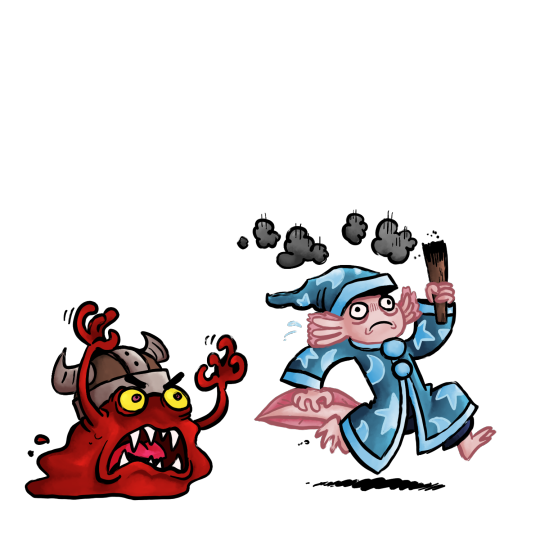
And that’s a basic overview of my game! I have two versions: a full size version and a smaller cheaper mint-tin version. Both contain the same gameplay and can be found here.
#board games#game crafter#the game crafter#single player#rpg#dungeon crawler#treasure by torchlight#board game
3 notes
·
View notes
Text
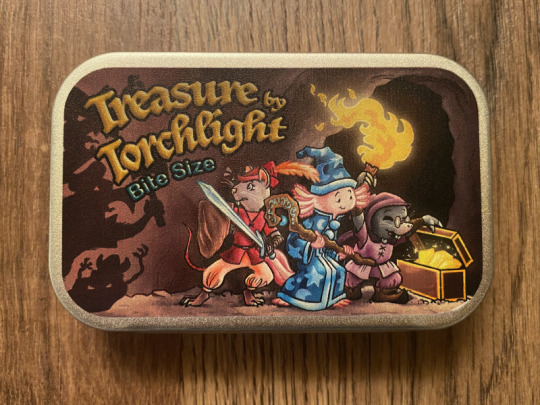


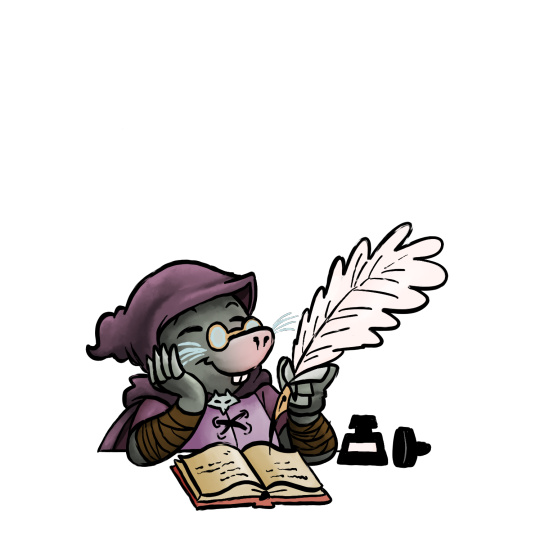
The cover art and some smaller incidental art made for the rules booklet for my Treasure by Torchlight single player dungeon crawling RPG!
(Artist wishes to be anonymous)
5 notes
·
View notes
Text
I made a single player RPG board game that features small rodents and mammals as dungeon explorers. The main sword fighter looks a lot like that character in the painting!
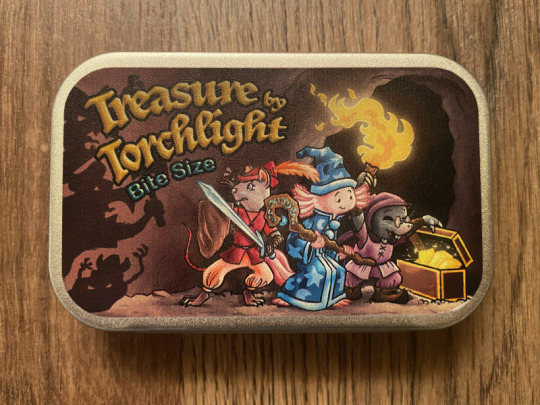

I AM THAT IS
#redwall#illustration#board games#game crafter#the game crafter#rpg#single player#treasure by torchlight
13K notes
·
View notes
Text
Instead of trying to promote a board game I made, I wanna do something fun and explain the process of play-testing and designing my game!
The Initial Concept
I like D&D as a concept. I love the idea of exploring dungeons, collecting treasure, and being a hero in a fantasy setting. But I have severe ADHD, I’m terrible at math, and don’t have many friends I can reliably play D&D with.
So the initial idea I had was to make a single player board game, that has customizable pieces, randomly generated dungeons, and a simplified attack system. I’d also like to publish this through The Game Crafter so I need to find ways to try and keep the cost down and keep it relatively small.
The First Prototype
The first step was to make the randomly generated dungeon tiles. This was going to be the primary way you’d interact with the rest of the game, and it’s most exciting feature in my opinion. I settled on puzzle pieces because they’re small but would still connect together in satisfying ways.

But this left me with the first of many problems. How do you move through the dungeon? You can’t roll a dice, because you’d quickly either run out of room or spend a lot of time wasted backtracking. We’ll come back to this later. For now I just needed something that fit together.
I came up with the idea of having some dungeon tiles contain treasure chests on them, and some with skulls. Treasure would mean you’d get loot, and skulls would mean you’d fight monsters. This way as you traverse the randomly generated dungeons you would have randomly generated encounters too.
When attacking enemies I wanted the system to be simple. A sort of Hero’s Quest style of attack where rolling dice and reading their outcomes would be how you’d determine how powerful your attack or damage would be. At this stage I settled on 3 wooden dice with skulls on some sides. To keep track of the enemy’s health I settled on using small 8mm cubes that you could move down the card as they took damage.
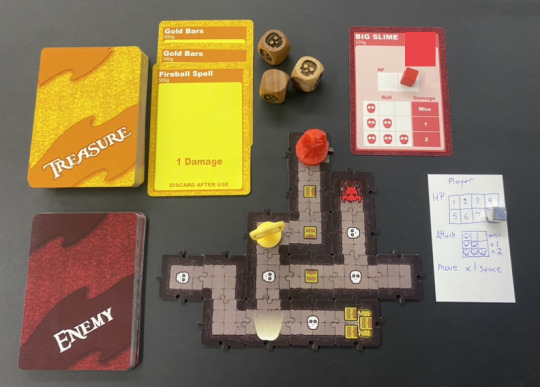
Probably the most ambitious thing I wanted to make was a modular character tracker. The goal of which would be that you can swap out the health, attack, and player character as you grow and gain experience. This would provide you with more attack power, more health, etc.
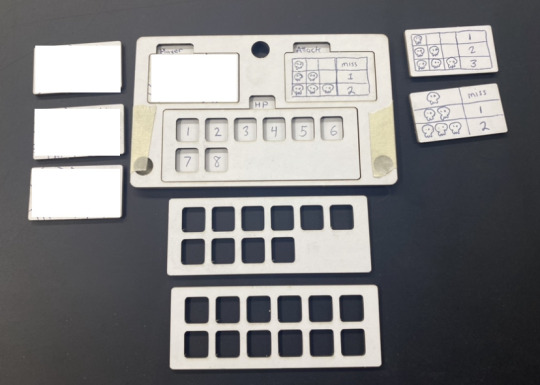
I settled on 4 interchangeable characters with the vague idea that down the road I would like them to have special powers, making each one unique and helping the player pick a character that fit their play style.
To round things out I added some domino mats to keep the layout of all the gameplay elements in check, and some play money to keep track of treasure.
The First Playthrough
The first impressions I had was that I was on the right track. The puzzle pieces worked beautifully. Likewise encountering enemies and treasure was easy too. The game mats were a bit cumbersome, but I loved the tactile feel of moving the HP down when attacked, and swapping out modular parts as you leveled up your character.
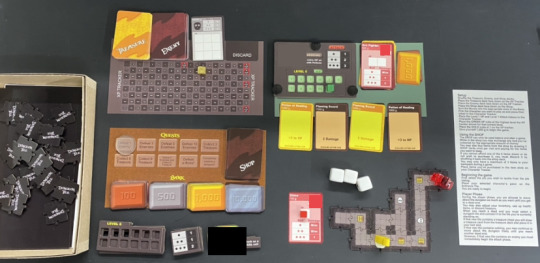
However, one of the immediately apparent issues was movement. How do you move through this randomly generated dungeon? You can’t do it through dice rolls, and if you just move by yourself on your turn it makes backtracking boring. Once a dungeon was explored there was no danger anymore, and it was trivially easy to escape if you were in a pinch.
Additionally the domino mats I added were helpful… but cumbersome. I included an XP tracker, but the problem was that keeping track of your XP level required a LOT of space. If you only level up at level 20 or 40, you need 20-40 empty squares in between to keep you place as you gain XP. That meant an entire domino mat was dedicated entirely to tracking the XP, and it looked like a spreadsheet.
Simplifying Solutions
Ideally you’d want a way to keep track of your movement, but I did not have much space on my character tracker to do that. One of the play testers I had try my game suggested I keep track of movement with a D6. You would rotate the dice as you moved and gradually spent movement points down.
This was an AMAZINGLY helpful solution! Now movement was restricted, you couldn’t just exit a dungeon whenever you wanted, it offered gameplay challenges and potential to upgrade your movement slots as you leveled up!
This one change suddenly opened up the game and created a risk/reward system that made finding treasure and leveling up through defeating enemies super important!
To solve the XP tracking I reduced the giant domino mat of 100 boxes into a simple abacus. Two rows. Top row are 1’s, bottom row 10’s. Now you could track your progress from 0-99 XP while freeing up the mat to include other information instead.
Then there was the problem with rolling attacks. With the 3 dice setup, it was easy to get stuck in a loop of constantly rolling blank sides (missed attacks) for both player and enemies alike. While browsing around the Game Crafter website I stumbled across a dice that has 3 outcomes. 0, 1, 2. It’s called a betrayal dice and it was just what I needed!
With this one dice I could now make the attacks scale depending on the outcome! If you rolled a 0 as a level 1 character you’d miss, but if you rolled a 0 as a level 6 character you’d do 2 damage! All I needed was a chart that showed what the outcomes were and this could be a part of the character tracker that you’d swap out as you leveled up!
The Second Playthrough!
After another round of play testing I was finding myself enjoying playing the game quite a bit. It had a nice feedback loop that appealed to my ADHD brain. But there were still a few little things that were bugging me.

For starters, rotating the D6 every time you moved was cumbersome and annoying, especially since the numbers on the sides weren’t placed in intuitive ways. I found myself struggling to find the right number to move down from, and after doing that 100 times over through multiple sessions it was getting tedious.
The obvious solution was to have a tracker you could put a 8mm cube in like I had with HP. It would reduce the stress and allow for the movement to upgrade along with XP. The problem was space. With all of these laser cut component I was running out of room to fit everything. The Game Crafter charges by the sheet, and I only had one sheet of chipboard to fit everything on.
The other issue was I kept encountering situations where nothing would happen for long stretches of exploration. There were blank dungeon tiles mixed in between the treasure and enemies, and that resulted in some quests having no treasure OR enemies and quickly running out of your movement points before you could find anything. This was especially noticeable during the early portion of the game.
Enemies too could just be straight up brutal. Randomizing the deck kept things interesting, but it could be extremely easy to get wiped out by a high level enemy when you were low level. If you didn’t have the foresight to stock up on powerful weapons and health potions at the shop before hand, you could be in for a rough time.
And finally I had no real reason to swap out the characters. I had initially included 4 different player avatars you could pick from, with the idea that each had a special power to help you out. But I was finding that I often forgot I had powers at all and would frequently venture through quests never even using them.
I was having fun with the game, but it was becoming increasingly clear that I needed to tweak things again to fix these problems.
Choices!
While doing some research into game design I came across a post that talked about the importance of player choice. The theory was that at no point should a player be doing nothing on their turn. Randomization is fun and all, but the player should still always be making a choice of some kind to keep them engaged.
With that in mind I went back to work retooling my game with an emphasis on choice.
For movement I got rid of empty tiles except for T-section dungeon tiles. Now whenever you encountered a blank T-Tile, you would draw 2 additional dungeon tiles, place them on either side of the T-section, and then you’d have a choice of which direction you wanted to go and engage with.
This worked wonderfully! If you were on a quest to collect treasure, now the player would have a choice to chose the treasure option instead of an enemy, and vice versa! This also greatly reduced the number of tiles on the chipboard that needed to be cut, freeing up more room for other pieces.
With that extra space no, I decided to commit to the modular movement tracker instead of using a D6 to track how many movement points you had left. Now just like your HP, you’d keep track with a small 8mm cube that you’d move (far less cumbersome) and the modular nature meant that it could be upgraded easily as you earned XP!
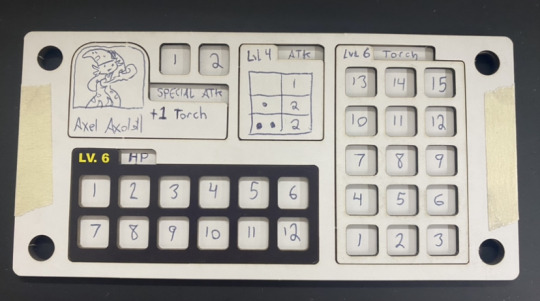
This focus on choice extended into the treasure too. I began adding locked treasure cards that you’d need to open. You could roll a dice and depending on the outcome you’d either open it or fail to open it. OR the player could spend one movement point for a guaranteed open! This introduced a risk/reward choice for the player. If money was tight they could spend precious movement points to unlock it, or they could take a gamble and roll the dice in the hopes that they’ll be lucky!
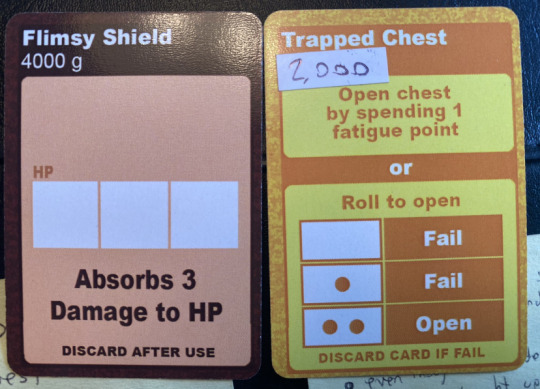
I had introduced a shop that sold items, but now I added an on sale item. If you could complete a quest successfully not only would you get a little bonus money, but one item at the shop would go on sale for 1/2 off! This offered incentive to complete quests and not just run away when things got hard.
Kill your darlings!
There was one last issue I had to contend with. The special attacks. They were still useless. Up until this point I had had 4 interchangeable characters each with their own special attack. One regained HP, one did an extra point of attack damage, one regained your movement points, and one was able to unlock locked treasures.
For some reason these 4 options felt lopsided. I wasn’t sure why until I re-examined the specials and their function. I realized that my character tracker had 3 main areas that upgraded as you earned XP. Your HP, Attack, and Movement. But I had 4 characters you could swap out, which meant I needed one extra special that didn’t easily conform to what the tracker tracked.

And this is when I made a tough decision. I cut out one of the 4 heroes. Suddenly everything fell into place. Your sword wielder would do one extra damage, your wizard would regain HP, and your rogue could refill your movement. 3 characters, 3 powers, 3 modules that upgraded as you became stronger.
It was sad to see one of the heroes go, especially since art for them had already been made. But unfortunately cutting them was the right decision. And the additional space allowed me to fit in more movement modules.
Final Touches!
I was still struggling with specials though. I needed a way to keep the player aware of them. I needed… to track them.
This was a scary realization so late into development. I had little room on the chipboard to create more modular pieces, but I needed something to ensure players would remember they had specials at all.
That’s when I had the idea to tie specials to the enemies you collected in dungeons. I could very easily add a little dot on an enemy card that would indicate how many special points you’d gain from them if you traded them in for a special cube you could put on your tracker.
Now again there was a player choice. To get a Special Point you now has to weigh your situation and decide if it was worth giving up potential XP in order to use your specials. And when some of those specials include refilling your HP or movement points, that could become a crucial decision to make if you’re in a tight spot!
The final thing I did was make enemies color coded and have 2 different attacks depending on what level your XP was at. Low level enemies are green, mid level enemies are orange, and high level enemies are red. And since there were 6 times you’d level up during the course of a full game, that meant enemies scaled up as you scaled up. I even wrote a rule to shuffle in the high level enemies as you progressed so you weren’t always encountering dangerous enemies when you were still too low to defend yourself.

Treasure by Torchlight!
Since so much of the movement in the game revolves around movement points being spent, I decided to call these points Torch Points and focus the game around the concept of going into dungeons and fighting monsters while trying to keep your torch lit. Once it goes out you can still move, but monsters attack more frequently and so there’s always incentive to keep your torch light lit!
You now got to pick your character, use their specials to your advantage, explore random dungeons, fight monsters, collect XP and loot which could be converted into special attacks, and buy items from a shop that rewarded you for successful quests!
I made an entire D&D style single player game that requires no math, has lots of replay-ability, and is relatively compact! There’s enough randomness in the cards and tiles to keep things interesting and different every time, while also providing the player with lots of ways to make decisions and have an active choice in their gameplay experience.
I think ultimately I was successful in my mission, and I am very happy with the results! It tickles the ADHD parts of my brain that loves exploring maps and planning for my next adventure without being overwhelming.
If you’ve made it this far then THANK YOU for listening! I hope you found this exploration of gameplay design interesting and if you’re curious about checking out the game it can be found here:
https://www.thegamecrafter.com/games/treasure-by-torchlight
11 notes
·
View notes
Text
Tricky Goblins (2024)
To me, the purpose of crowdfunding a board game or tabletop project should be to help independent game designers get their product out there. It should make these smaller, unique titles more accessible to gamers around the world.
This is why I like the GameCrafter method of Crowd Sales. The GameCrafter uses Crowd Sales to fund indie board games and with the more pre-sales that are made, the…

View On WordPress
1 note
·
View note
Text
My game The Longest Week made it to the semi-finals!
Semi-finalists Announced for "The 1 Pound Challenge"
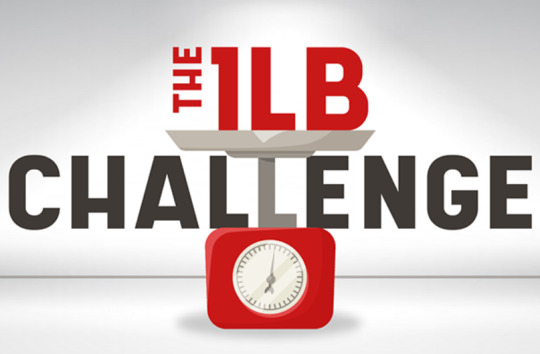
The Semi-Finalists have been announced for The 1 Pound Challenge.
#contest#game design#board game design#game designer#the game crafter#board games#game crafter#single player#zombie apocalypse#zombies#the longest week
2 notes
·
View notes
Text
I need to try and challenge myself into making a card game. I struggle with card games because without something tangible to interact with (like a meeple or playfield board) I get easily distracted. And there’s a level of abstraction that occurs with card only base games that makes it difficult for me to focus.
0 notes
Text
I deliberately designed my dungeon crawling board game around this main issue. I have ADHD and I can’t stand having super complicated rules or needing to deal with math.
So all enemy and player attacks are decided by the outcome of your dice rolls. And your character stats are clearly visible and tracked with cubes that either go up, or down. The most math involved is when you need to buy or sell items and I kept it at a base 10 level for ease.
If ever I’m playing my own game and I get confused, I know that’s an area that I need to work on to make it less stressful.

9K notes
·
View notes
Text
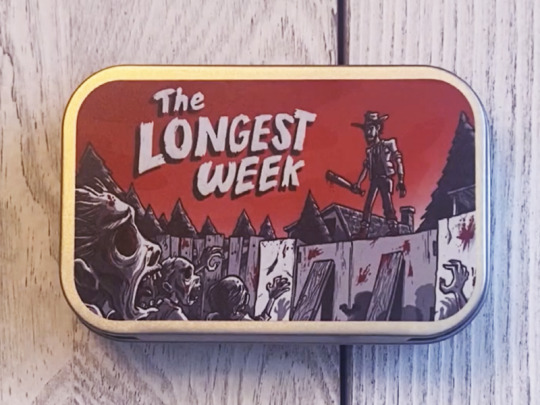
My zombie apocalypse game The Longest Week is a semi-finalist in the One Pound Challenge contest on the Game Crafter’s website!

The challenge is to make a game that packs as much game as possible into a box that weighs 16oz or less!
2 notes
·
View notes
Text
I feel this every day. I make board games. I love making board games! I love puzzling out the various ways elements work together and play and finding the right ways to fit components into boxes and writing up my instructions on how to play…
But I am terrible at advertising. I don’t want to do it. I don’t like doing it. I feel awful trying and the amount of shame and fear I feel whenever I try is overwhelming.
The website I go through has a feature where the more games that sell during a crowdsale, the cheaper it will become for everyone. So in that way the website is deliberately trying to get me to advertise.
And I keep getting asked “when will you crowdsale? Why aren’t you crowdselling? Don’t you want to make money? This is the fastest way to make money for your game!” And I’m just paralyzed with fear and anxiety and don’t know how to follow through.
I just wanna make games.
I don’t wanna advertise! 😞
circling back around to the issue of writers being expected to do all their own goddamn marketing via social media these days, because it completely nixes the possibility of writers being weird shut ins, off-putting eccentrics, or misanthropes. 80% of the literary canon was written by weird shut ins, off-putting eccentrics, and misanthropes. if you weed out everyone who’s the wrong kind of insane to maintain a twitter presence, who on earth is left
60K notes
·
View notes
Text
One of the reasons I made Treasure by Torchlight the way I did is because I wanted to make something that appealed specifically to me. I have ADHD and I made every aspect of my game work for my ADHD brain.
Problem:
I wanted to make a D&D style game where you can level up your characters, but I’m bad at math and my brain refuses to keep short term information saved properly.
Solution:
I made everything visual and tactile. Part of the reason my game has so many components is because I like being able to swap out the pieces and change how my character tracker looks and plays. I made an abacus to track the stats with cubes, and I included a way save the data so I can come back to it later.

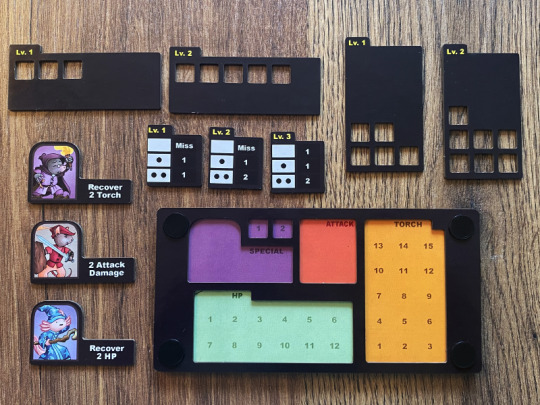
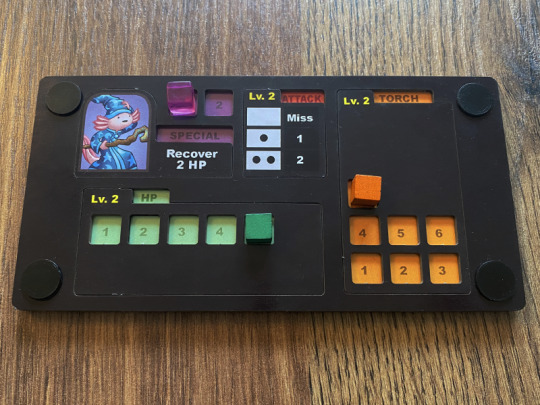

Problem:
I wanted to make a dungeon crawling game, but cards don’t always lay flat and could turn accidentally and take up a lot of space.
Solution:
I made the dungeon puzzle pieces that connect together. Now no matter how many times I play my game, it all comes together nicely and I have unique dungeons that stay pieces together!
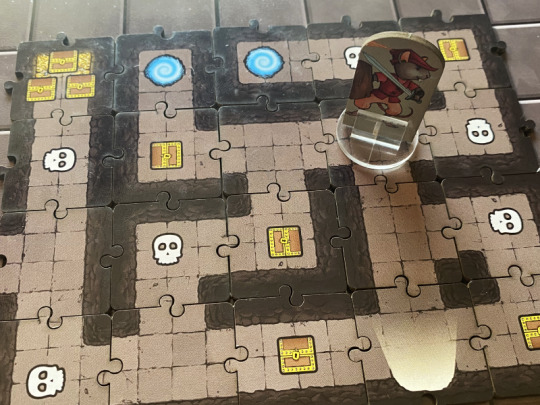

Problem:
Enemies become easier the stronger I become. I need a way to keep them engaging even after fighting them 100 times.
Solution:
I added levels to the enemies. Once you reach a higher level, they start doing higher attacks!

Every part of this game was designed so that my ADHD would vibe with it!
6 notes
·
View notes
Text
i do unironically think the best artists of our generation are posting to get 20 notes and 3 reblogs btw. that fanfic with like 45 kudos is some of the best stuff ever written. those OCs you carry around have some of the richest backstories and worldbuilding someone has ever seen. please do not think that reaching only a few people when you post means your art isn't worth celebrating.
58K notes
·
View notes
Text
youtube
This is my zombie apocalypse tower defense style mint-tin game.
You’ve managed to find shelter and call for help, but help won’t be able to arrive until the end of the week. That gives you 7 days to strengthen your defenses, farm for food, and scavenge for weapons. But every day that passes the zombie horde outside grows stronger and stronger.
Can you survive the week?
This is both a single player or two player cooperative game. Every day you’ll have 3 turns (morning, noon, and evening) to prepare. You can either scavenge for guaranteed hit weapons outside, farm for food to replenish HP and Attack, or gather resources to strengthen the gate. But when night falls, the horde attacks! While taking out zombies isn’t hard, as the horde grows and you’ll start to run out of attack power and weapons fast.
Once the horde outside is dealt with, you advance to the next day, increase the strength of the horde and try again. Make it through all 7 days to get rescued and win!
You’ll need to be strategic about how you play. Resources are finite and if you’re not careful you might just run out of resources right when things are getting intense! Additionally, scavenging for weapons might seem beneficial… but it might also attract unwanted attention and you could accidentally increase the strength of the horde while searching for weapons!
If you’re playing two player cooperative, only one of you needs to make it out alive for both of you to win. Share your weapons and items with your friend using the storage slot! The two player mode also includes special cards that make the game a little more unpredictable and challenging.
So I’ll ask again:
Can you survive the week?
#the game crafter#board games#game crafter#rpg#single player#two player cooperative#two player#zombie#zombie apocalypse#mint tin#Youtube
1 note
·
View note
Text
Shoutout to that time I was making a Zombie Apocalypse game for 4 1/2 months and never once realized that I spelled horde wrong until AFTER I published it.


It’s suppose to be horde. Not hoard. I’m not hoarding zombies in my basement or anything. I’m trying to protect myself from the zombie horde!
(I fixed it immediately when I found my mistake but by that time the YouTube tutorial video was already filmed so… my mistake will live on forever.)
2 notes
·
View notes
Text
I really enjoy making games, but the biggest problem I keep encountering is price. It is VERY hard to keep the price down for your own games. Sometimes just adding a box will increase the price of your game by $10! When you’re trying to keep the price down for the customer that extra $10 can be a dealbreaker.
This is why I like Mint-Tins. They’re small. They’re portable. And they force you to think outside the box and come up with creative ways to tell your story with a fixed number of components and pieces.
The trade off, however, comes at the cost of clarity in the playing field. Playfields are important in board game design because they take your abstract concepts and give them shape and meaning. They create order for your rules and help facilitate the ease of your gameplay experience.
Take my Treasure by Torchlight game for example. I decided to try and make a cheaper alternative to the full game by condensing it all into a mint-tin. And look what happened to the playfield in the process. I had to break it up into multiple cards that not only take up space in the mint-tin, but can sometimes result in the pieces of the playfield not being very orderly.

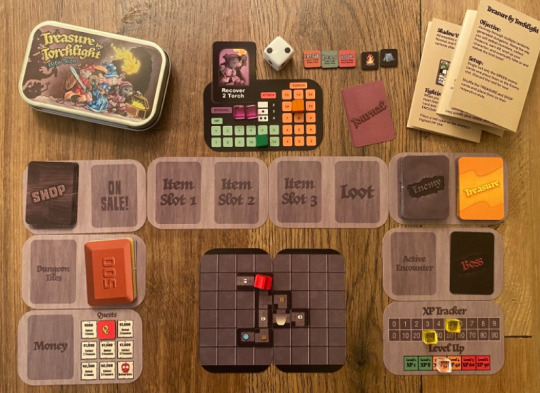
That’s why I’ve been trying to find alternative ways to fit a larger playfield into a mint-tin. I noticed that The Game Crafter has a variety of folding mats which are relatively cheap components to print and cut up. But unfortunately they didn’t have any that folded up to fit in a mint-tin.
But they DO allow you to make your own custom cut cardstock mats!
So I made my own!
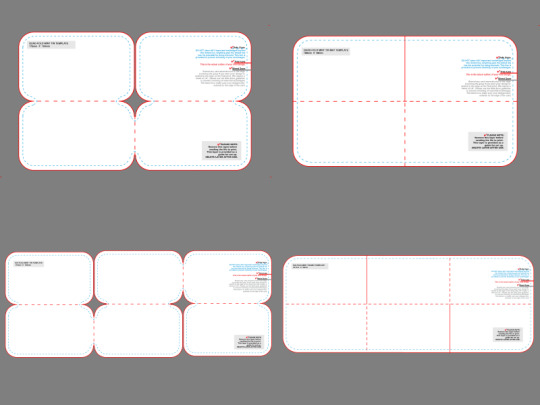
I made a variety of mint-tin card sized mats that all fold on perforated edges. My largest mat is 9.5x6 inches large! For a game that fits in such a compact container, every inch of space is invaluable!
I experimented with the card shaped one for my Zombie game and I think it worked out really well! So now I’m working on making a game that takes advantage of the even larger mat. I hope to have details about it in a little bit, but for now here’s a little preview of what it looks like!

I love how much constrained restrictions force you to think outside the box! I never would have thought to make these custom cut mats if it weren’t for my attempt to try and fit my large game into a Mint-Tin!
(Incidentally I sell the cut files on my page for anyone to use in their own games! Go nuts!)
#the game crafter#board games#game crafter#rpg#single player#dungeon crawler#dungeons and dragons#pirates#zombie apocalypse#zombie
6 notes
·
View notes
Text
Here’s a series of board games I’ve made recently.
Astro Asterid’s Quick Shuttle Repair

Derelict ships in space need to be fixed quickly, so they call on Astro Asterid to repair them! Carry resources through the halls of various ships to repair systems that have crashed. The more resources you carry, the slower you move, and the more likely more systems will go offline! Move quickly but strategically to repair all the systems before time runs out!
Treasure by Torchlight

A single player dungeon crawling role playing game featuring cute little mammal characters in a fantasy setting. Journey through dungeons collecting treasure and defeating monsters to level up your character so you can take on the final boss! But be careful, with every step you take your torchlight grows dimmer. Keep that torch lit as you explore randomly generated dungeons!
Treasure by Torchlight: Bite Size
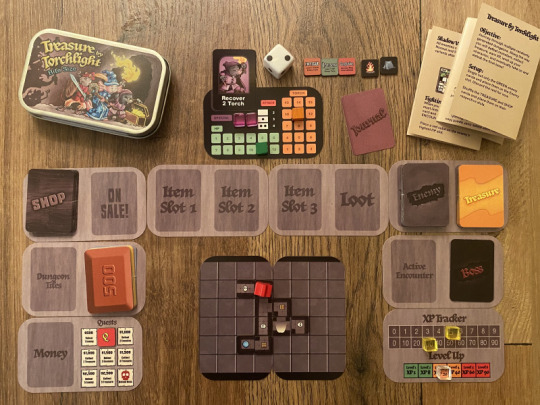
This is a mint-tin version of the same game. This “bite size” version contains everything the full size game does. An enormous game in a tiny package!
Noah’s Ark

A very simple mint-tin game for young players. Move down the landscape collecting animals and bringing them one by one back to the ark. But hurry up! The flood waters are rising! Count up points at the end of the game and see if you got a high score!
The Longest Week

In the middle of a zombie apocalypse you manage to find shelter and call for help. However, help won’t arrive for 7 days. During the day scavenge for weapons, farm for food, or gather resources to strengthen your gate because when night falls the zombie horde attacks! As the days progress the horde outside grows larger and stronger. Can you survive the week and be rescued?
All of these games can be found with more information and prices on my storefront on The Game Crafter website here!
#the game crafter#board games#game crafter#rpg#single player#zombie#noah’s ark#mint tin#zombie apocalypse#dungeon crawler#dungeons and dragons
581 notes
·
View notes
Text
I just spent money on a final test print for a new game I’m working on as I prepare to launch it, and I just noticed a rather large mistake. It’s too late to fix it now, so I’ll have to pay for a second test print after I fix it. How frustrating…
1 note
·
View note